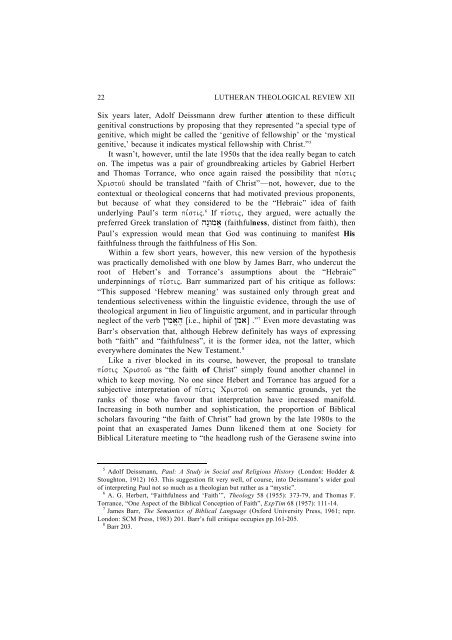LUTHERAN THEOLOGICAL REVIEW - Concordia Lutheran Seminary
LUTHERAN THEOLOGICAL REVIEW - Concordia Lutheran Seminary
LUTHERAN THEOLOGICAL REVIEW - Concordia Lutheran Seminary
Create successful ePaper yourself
Turn your PDF publications into a flip-book with our unique Google optimized e-Paper software.
22 <strong>LUTHERAN</strong> <strong>THEOLOGICAL</strong> <strong>REVIEW</strong> XII<br />
Six years later, Adolf Deissmann drew further attention to these difficult<br />
genitival constructions by proposing that they represented “a special type of<br />
genitive, which might be called the ‘genitive of fellowship’ or the ‘mystical<br />
genitive,’ because it indicates mystical fellowship with Christ.” 5<br />
It wasn’t, however, until the late 1950s that the idea really began to catch<br />
on. The impetus was a pair of groundbreaking articles by Gabriel Herbert<br />
and Thomas Torrance, who once again raised the possibility that pi,stij<br />
Cristou/ should be translated “faith of Christ”—not, however, due to the<br />
contextual or theological concerns that had motivated previous proponents,<br />
but because of what they considered to be the “Hebraic” idea of faith<br />
underlying Paul’s term pi,stij. 6 If pi,stij, they argued, were actually the<br />
preferred Greek translation of hn:Wma/ (faithfulness, distinct from faith), then<br />
Paul’s expression would mean that God was continuing to manifest His<br />
faithfulness through the faithfulness of His Son.<br />
Within a few short years, however, this new version of the hypothesis<br />
was practically demolished with one blow by James Barr, who undercut the<br />
root of Hebert’s and Torrance’s assumptions about the “Hebraic”<br />
underpinnings of pi,stij. Barr summarized part of his critique as follows:<br />
“This supposed ‘Hebrew meaning’ was sustained only through great and<br />
tendentious selectiveness within the linguistic evidence, through the use of<br />
theological argument in lieu of linguistic argument, and in particular through<br />
neglect of the verb !ymia/h, [i.e., hiphil of !ma] .” 7 Even more devastating was<br />
Barr’s observation that, although Hebrew definitely has ways of expressing<br />
both “faith” and “faithfulness”, it is the former idea, not the latter, which<br />
everywhere dominates the New Testament. 8<br />
Like a river blocked in its course, however, the proposal to translate<br />
pi,stij Cristou/ as “the faith of Christ” simply found another channel in<br />
which to keep moving. No one since Hebert and Torrance has argued for a<br />
subjective interpretation of pi,stij Cristou/ on semantic grounds, yet the<br />
ranks of those who favour that interpretation have increased manifold.<br />
Increasing in both number and sophistication, the proportion of Biblical<br />
scholars favouring “the faith of Christ” had grown by the late 1980s to the<br />
point that an exasperated James Dunn likened them at one Society for<br />
Biblical Literature meeting to “the headlong rush of the Gerasene swine into<br />
5 Adolf Deissmann, Paul: A Study in Social and Religious History (London: Hodder &<br />
Stoughton, 1912) 163. This suggestion fit very well, of course, into Deissmann’s wider goal<br />
of interpreting Paul not so much as a theologian but rather as a “mystic”.<br />
6 A. G. Herbert, “Faithfulness and ‘Faith’”, Theology 58 (1955): 373-79, and Thomas F.<br />
Torrance, “One Aspect of the Biblical Conception of Faith”, ExpTim 68 (1957): 111-14.<br />
7 James Barr, The Semantics of Biblical Language (Oxford University Press, 1961; repr.<br />
London: SCM Press, 1983) 201. Barr’s full critique occupies pp.161-205.<br />
8 Barr 203.













